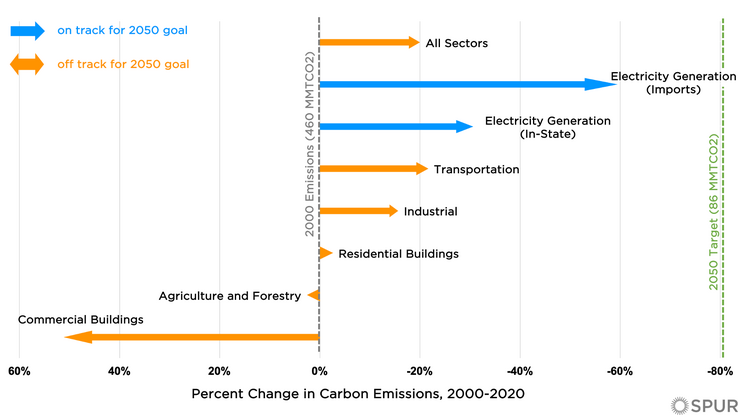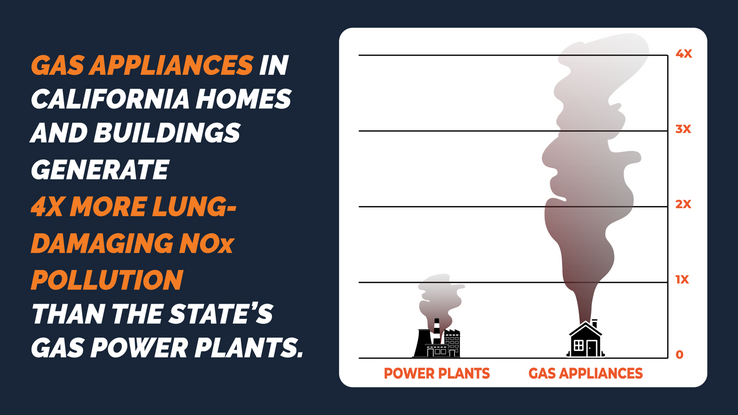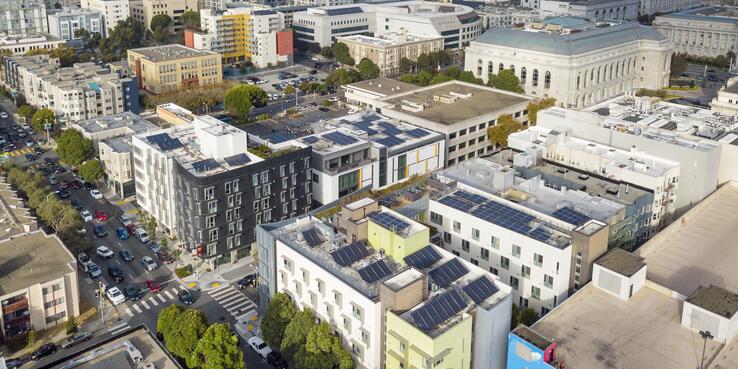California has made remarkable progress over the past two decades in reducing climate pollution across its major economic sectors, but there is one notable exception: buildings, including our homes and workplaces. The state’s failure to make a meaningful dent in onsite building emissions, which make up 10% of all emissions, is making it increasingly unlikely we’ll hit our climate targets. This realization should keep us all up at night because scientists have warned that the globe must reach carbon neutrality by 2050 to avoid the kinds of wildfires, droughts, floods, heat waves, and hurricanes that will make the recent years of record-setting weather look like child’s play.
The state’s data on greenhouse gas emissions highlight the widening gap between the buildings sector and other sectors. Between 2000 and 2020, emissions from the state’s homes decreased by a mere 3%, and emissions from commercial buildings actually increased by a staggering 51%. Over the same period, in-state electricity generation emissions fell by 31%, and transportation emissions decreased by 22%.
Sectoral Carbon Emissions Trajectories in California, 2000–2020

Source: SPUR analysis of Next 10. 2022 California Green Innovation Index, 2022.
Of all of California’s major polluting sectors, commercial buildings are now the furthest off track for meeting the state’s emissions targets. But it’s not just our state’s progress in meeting these targets that has suffered — our air quality has also suffered.
Gas appliances in California homes and buildings generate four times as much lung-damaging nitrogen oxide (NOx) pollution as the state's gas power plants and roughly two-thirds as much NOx as all of the state’s passenger cars.

Building pollution is one reason California fails year after year to meet legally binding federal air quality standards that protect health. Historically, cleaning up gas combustion in buildings hasn’t been a priority for state or federal regulators. Contrast this failure with the success regulators have had in cleaning up power plants, reducing NOx emissions 87% since 1995 nationwide.
Gas heating equipment blocks climate and air quality progress in the buildings sector.
Onsite building emissions have two components: burning of fossil fuels such as gas for heating and cooking and leakage of refrigerants from appliances such as refrigerators and air conditioners. Between 2014 and 2019, gas use surged 15.3% in commercial buildings and 17.8% in residential homes. Only in 2020 did gas use in homes finally tick down — but by just 0.64%.
To get the buildings sector back on track, California must leverage its rapidly greening electricity grid to transition homes away from gas. Replacing burnt-out gas appliances with electric appliances like heat pumps for both space and water heating would cut climate pollution from the average California home by more than half over the next 15 years. By 2050, moving from fossil fuels to electric appliances powered by clean energy could reduce greenhouse gas emissions from California’s buildings by up to 90%.
In charting a path forward for homes and other buildings, California can look to lessons from transportation-sector strategies. One of the most important of those lessons regards equity. Electric vehicles (EVs) zip down California's highways due to the emissions standards set by the state as far back as 1990 — but the inequitable implementation of these standards favored EV adoption by higher-income households, leaving low-income communities, as well as many communities of color, behind.
California currently lacks an analogous law for homes and buildings, and it’s a gaping hole in the state’s climate strategy. But in crafting new emissions standards for the sector, the state must ensure that, this time around, low-income communities are able to fully participate in the transition to less polluting and healthier homes and workplaces.
AB 593 will make cutting pollution from homes and buildings a priority.
A bill before the California legislature, AB 593 (Haney), will help get emissions from homes and buildings back on track by directing the California Energy Commission to develop a pollution-cutting plan for the sector, complete with milestones to ensure the state stays the course. The bill is sponsored by the Building Decarbonization Coalition and supported by SPUR, environmental groups, utilities, and labor advocates.
The transition to zero-emission homes represents a win for everyone in the form of cleaner air, more affordable energy bills, and safer infrastructure. AB 593 will support California in upgrading its building stock in a way that maximizes benefits for communities, the workforce, and industry alike.
Community benefits: Upgrading California’s homes and buildings should be a priority for the state not just because this sector is dramatically off track for meeting the state’s climate goals, but also because built infrastructure is the first line of defense against climate impacts. Homes that have undergone holistic clean energy retrofits can keep communities safer during heat waves by providing efficient cooling. Zero-emission heat pumps boost resilience by filtering out air pollutants like smoke during wildfire season.
Thoughtful implementation of AB 593 will help our state center equity in the transition to clean energy in homes. In the early days of the EV transition, tax breaks and subsidies were mainly accessed by the wealthy. Today, the state and the federal government are providing massive heat pump subsidies for low-income households. Policymakers will need to ensure that these subsidies are maintained at least until heat pumps reach cost parity with gas equipment.
Workforce and industry benefits: AB 593 will help create new opportunities for California’s workforce. Upgrading California’s 14 million homes and 8 billion square feet of commercial building space to run on clean energy could support more than 100,000 full-time workers in the construction industry and as many as 4,900 full-time manufacturing workers, according to an analysis from UCLA.
State action is needed to bolster local leadership on buildings.
Until recently, local governments in California led the charge to cut pollution from homes and buildings by adopting more than 75 local ordinances incentivizing or requiring all-electric new construction.
But earlier this year, a widely criticized court ruling on the City of Berkeley’s gas ban dealt a major blow to local authority to transition new homes away from fossil fuels like gas. In the wake of this ruling, it’s time for state leaders to step in with a cohesive strategy to address climate and air pollution from homes and buildings.
We cannot afford to wait any longer to tackle California's most overlooked climate problem. We need a comprehensive statewide approach, and that’s exactly what AB 593 will deliver.
